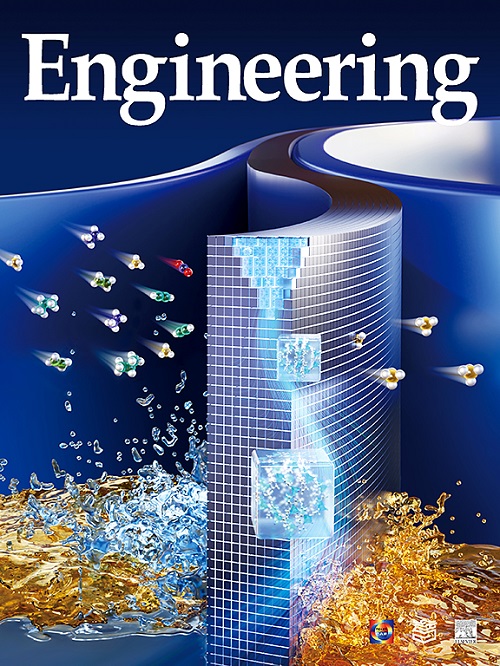Highly Selective Removal of Perchlorate from Water: Roles of Unconventional Hydrogen Bond and Hydrophobic Cavity
IF 11.6
1区 工程技术
Q1 ENGINEERING, MULTIDISCIPLINARY
引用次数: 0
Abstract
Selective perchlorate (ClO4−) removal from surface water is a pressing need due to the stringent perchlorate drinking water limits around the world. Herein, we anchored N+–C–H hydrogen bond donors in hydrophobic cavities via interactions of cationic surfactants with montmorillonite to prioritize perchlorate bonding. The prepared adsorbent exhibited high selectivity over commonly occurring competing anions, including SO42−, NO3−, PO43−, HCO3−, and halide anions. High adsorption capacity, fast adsorption kinetics, and excellent regeneration ability (removal efficiency ≥ 80% after 20 cycles) were confirmed via batch experiments. Unconventional CH···O hydrogen bonding was verified as the primary driving force for perchlorate adsorption, which relies on the higher bond energy (∼80 kcal·mol−1) than conventional bonding. The removal efficiency of anions followed the order of the Hofmeister Series, demonstrating the importance of hydrophobic cavities formed by the tail groups of cationic surfactants. The hydrophobic cavities sheltered the C–H bonds from interacting with anions of low hydration energy (e.g., perchlorate). Furthermore, a fixed-bed column test demonstrated that about 2900 bed volumes of the feeding streams (∼500 μg·L−1) can be treated to ≤ 70 μg·L−1, with an enrichment factor of 10.3. Overall, on the basis of the hydrophobicity-induced hydrogen bonding mechanism, a series of low-cost adsorbents can be synthesized and applied for specific perchlorate removal.
高氯酸盐在水中的高选择性去除:非常规氢键和疏水腔的作用
由于世界各地严格的高氯酸盐饮用水限制,从地表水中选择性去除高氯酸盐(ClO4−)是迫切需要的。在这里,我们通过阳离子表面活性剂与蒙脱土的相互作用将N+ -C-H氢键供体锚定在疏水腔中,以优先考虑高氯酸盐键。所制备的吸附剂对常见的竞争阴离子(SO42−、NO3−、PO43−、HCO3−和卤化物阴离子)具有较高的选择性。通过批处理实验,证实吸附量大、吸附动力学快、再生能力好(循环20次后去除率≥80%)。非常规的CH··O氢键是高氯酸盐吸附的主要驱动力,它依赖于比常规键更高的键能(~ 80 kcal·mol−1)。阴离子的去除效率遵循Hofmeister级数的顺序,证明了阳离子表面活性剂尾部基团形成疏水空腔的重要性。疏水空腔保护C-H键不与低水合能阴离子(如高氯酸盐)相互作用。此外,固定床柱试验表明,约2900层体积的进料流(~ 500 μg·L−1)可处理至≤70 μg·L−1,富集系数为10.3。综上所述,基于疏水诱导的氢键机制,可以合成一系列低成本的吸附剂,并应用于特定的高氯酸盐去除。
本文章由计算机程序翻译,如有差异,请以英文原文为准。
求助全文
约1分钟内获得全文
求助全文
来源期刊

Engineering
Environmental Science-Environmental Engineering
自引率
1.60%
发文量
335
审稿时长
35 days
期刊介绍:
Engineering, an international open-access journal initiated by the Chinese Academy of Engineering (CAE) in 2015, serves as a distinguished platform for disseminating cutting-edge advancements in engineering R&D, sharing major research outputs, and highlighting key achievements worldwide. The journal's objectives encompass reporting progress in engineering science, fostering discussions on hot topics, addressing areas of interest, challenges, and prospects in engineering development, while considering human and environmental well-being and ethics in engineering. It aims to inspire breakthroughs and innovations with profound economic and social significance, propelling them to advanced international standards and transforming them into a new productive force. Ultimately, this endeavor seeks to bring about positive changes globally, benefit humanity, and shape a new future.
 求助内容:
求助内容: 应助结果提醒方式:
应助结果提醒方式:


